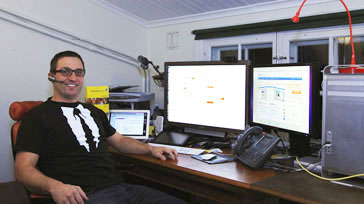Teleworking
What are the benefits and challenges of telework in communication technologies and financial services?
ILO Global Dialogue Forum explores how teleworking can provide a better work-life balance for employees, lead to greater productivity for employers and help governments promote inclusive job opportunities.

A Global Dialogue Forum organized by the ILO in Geneva from 24 to 26 October brought together representatives of governments, employers and employees from around the world to discuss policies and practices that can address decent work challenges and maximize the benefits of teleworking in the information and communications technology services (ICTS) and financial services sectors.
Participants agreed that teleworking can provide numerous work and social benefits. “Worker benefits can vary from shorter commutes, lower work-related personal expenses and better work-life balance, including a better ability to balance professional and care responsibilities, and more work opportunities,” they said in a points of consensus document issued at the end of the Forum.
“Employers can benefit from increased productivity, lower overhead costs, and access to a larger and more diverse, motivated and skilled labour pool. For governments, teleworking can be a strategy to address urban congestion and environmental problems, and to promote inclusive employment opportunities for all.”
However, teleworking in ICTS and financial services can pose a number of sector-specific and decent work challenges, including issues related to cybersecurity, privacy or the exposure of confidential information. In the absence of appropriate arrangements, workers can face psychosocial problems related to isolation and blurred lines between work and private life. They can have less access to training and perceive a lack of career development. Occupational safety and health conditions are also more difficult to monitor and control in teleworking arrangements.
Talking to government, employer and worker representatives attending the meeting, ILO News found that country situations and needs differ considerably with respect to telework.
Telework: Opportunities and challenges
“Teleworking is not as prevalent in South Africa. We don’t even have a proper definition of what telework entails and as a result we don’t have legislation that governs telework. We would like the ILO to facilitate research to assist us with coming up with that definition and also with legislation because while there are advantages, there are also questions and challenges,“ said South Africa’s Deputy Minister of Labour, Nkosi S.P. Holomisa.Mr Holomisa also wondered about the question of working hours. “What happens there? Who determines what these are – is it a question of the hours or output that is considered when deciding remuneration? Questions of basic conditions, and, of course, the question of if the worker lives in a country different from that of his employer. Telework must be managed and regulated so we do not find ourselves taken by surprise.”
Andy Kerr, Deputy General Secretary of the UK’s Communications Workers Union described the UK as “quite advanced” in teleworking. “We’ve got some good regulations in place in the two sectors and we want to make sure basic rights such as health and safety and workers’ rights are extended into other companies and industries,” he said.
“Because different regions and countries are at different stages, we are looking to the ILO and its members to gather further research and data on telework, and to share best practices. We want to meet again within two years – perhaps as a smaller body – to go in-depth in order to get a global ILO agreement further down the line.”
That view was shared by Ecuador’s Minister for Labour and Employment, Leonardo Berrezueta Carrion. “The recommendation from Ecuador is to think about the future of work in the next 20 years, especially in the role that ILO has in supporting member states with technical assistance and the development of international forums to create a new international regulation that concerns teleworking,” he said.
Telework in the two sectors and beyond is also “an alternative for people with disabilities, deprived of their freedom of mobility, mothers at the stage of developing attachment with their children and the elderly who do not have access to job opportunities. But, above all, to the youth between 18 and 26 years old,” Carrion added.
Dasun Nalinda Kodithuwakku Kankanamge, Manager, Support Services and Information Technology at The Employers’ Federation of Ceylon, said there is growing interest among young people and employers in telecommuting in Sri Lanka.
“From the employers’ perspective, companies benefit as most of the businesses in Sri Lanka are located in the central city of Colombo, where it can take an hour and a half to travel 10km because of traffic,” he said. “It also benefits industries such as ICTS, where, for example, we are the main suppliers to the UK Stock Exchange System. But when it comes to the financial sector, it is quite resistant as our legal system doesn’t highlight teleworking anywhere because it is new. The main challenge for employers is how they will safeguard themselves in the legal framework.”
In Japan, Prime Minister Shinzo Abe has been encouraging companies to support workers who want to telework as a means of including people who have previously been shut out of the labour market.
About 10 per cent of the total workforce at Nippon Telegraph and Telephone Corporation (not just the two sectors) telework, according to Masahiro Kajiwara, Senior Manager with the company’s General Affairs Department (Human Resources).
“As a company, we have organized an environment in order that staff can easily take up telework. The challenge is that the pick-up rate is still very low and so we are still in the process of evolution.”